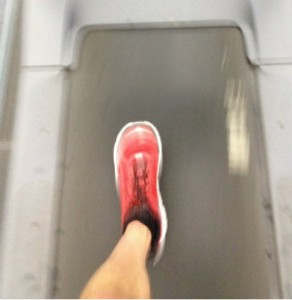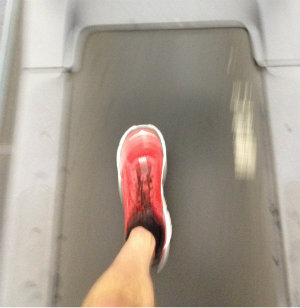Treadmill progression runs
 When you move your workouts onto the treadmill there are some advantages. In the winter we sometimes have to move inside to avoid the bite of Mr. Winter. This may also be turned into an advantage, giving you a more controlled workout by eliminating the variables or weather and topography.
When you move your workouts onto the treadmill there are some advantages. In the winter we sometimes have to move inside to avoid the bite of Mr. Winter. This may also be turned into an advantage, giving you a more controlled workout by eliminating the variables or weather and topography.
Here’s a good progressive workout that you can use that is not too stressful but gives you a good goal and something to keep your mind off the fact that you’re running on the treadmill!
First, a couple quick suggestions on preparation.
Bring a water bottle and a small sweat towel so you don’t have to dismount in the middle of the workout.
I like to listen to music or podcasts when I’m on the treadmill but I hate, with a capital H, headphone wires. Especially if you’re trying to run a harder workout. Inevitably you’ll tangle a hand on the wire and your phone will go shooting across the gym.
I’ve recently found a solution to this with a pair of over-the-ear, noise canceling Bluetooth headphones from SoundBot. They are less than $20. Th3 sound quality isn’t super, but they do the trick and at $20 I’m not so concerned about sweating them to death. The over-the-ear helps to drown out the treadmill noise and the devil-babble of any errant CNN TVs I’ve been unable to disable.
If I’m going to the gym to use the treadmill, especially this time of year when you have all the New-Year’s-Resolutionaries, I’ll try to go off peak hours. This is any time other than the standard morning-before-work, lunchtime or immediately-after-work. There’s nothing worse than not being able to find an open treadmill or having people giving you dirty looks.
Another great thing about being at the gym when there’s no one around is you can turn off all the stupid TV’s blaring CNN, ESPN and FOX news and Mexican soap operas… Serenity Now!
Next you have to remember is that most gyms and treadmills are operating under the assumption that you’re only going to be on the thing for 20-30 minutes. Some gyms have actual rules that you can’t stay on for more than X minutes at a time or have to reserve in blocks of X minutes. (Another good reason to go off peak)
95% of the time the machines themselves will automatically end workouts at 60 minutes. Knowing this, if you have, let’s say a 1:10 workout planned, do a 10 minute warm up, then stop and reset the machine so it won’t interrupt you at the end of your workout when you really need to concentrate.
An excellent way to warm up for a treadmill run or any gym workout is to do 5 minutes of barefoot running. Set the treadmill to the slowest speed you can stand. I mean slow! At least 2 min per mile slower than any of your training paces. Jump on in your bare feet, if your club allows it, if not use a pair of think tech socks.
Feel your feet hitting the treadmill belt. Really feel it. Focus on perfect form and fast turnover. Enjoy it. You’ll feel like a kid and you may even get dirty looks. Hips forward. Shoulders back. Head high. Quick light feet. Land on the forefoot pad, with your feet underneath your center of gravity, aligned with the base of your second toe.
Once you have your barefoot form dialed in focus on letting your feet relax and spread out. Experiment with ‘grabbing’ the belt with your foot. Feel it. Love it. Enjoy it. If you do this a couple days a week for 5 minutes you’ll be a better runner. It’s essentially a grounding and form drill cmbined with balance ans strengthening to prevent injuries.
Just remember to keep you barefoot pace super slow and easy. There should be no pounding. Your foot strike should be as light as a feather stroking a lover’s face.
After this awesome warm up you can put your shoes back on and run your workout. A key thing to realize about gym treadmills and treadmills in general is that they are not actual running. They are a simulation of running. Some will feel too easy. Some will feel too hard. Some will just feel strange. Feel free to jump around to the different models and different machines until you find one you like, but don’t assume they are going to be an exact replacement for road running. That assumptions will get you into trouble by setting bad expectations.
I know it’s easier said than done, but don’t worry so much about pace on the treadmill. It may be slower or faster than your regular outside running. Run by effort level or perceived effort level instead.
I like to set the incline on the treadmill at 1.0 or at least 0.5%. I think this better simulates road running. It also cleans up your form by forcing a bit of a forward lean. It is harder and will impact your effort and pace, but remember what I just said about pace, it’s not that important. (If you really want to get wrapped up in paces each 1% is estimated to be worth 10-20 seconds a mile in pace.)
http://www.hillrunner.com/training/tmillchart.php
Now let’s talk about a simple workout that you can do on the treadmill that is very worthwhile and engaging.
By the way, most gym treadmills will have some capabilities to be programmed, so you may be able to automate these workouts so you never have to hit a button during the workout. I hardly ever use any of the preset programs (heart rate, hills, etc.). I just hit the quick start and choose the pace/incline I want.
This simple workout meshes well with the controls available on the machine. Most of the gym treadmills default to MPH (or KPH) on the display and can be set, increased and decreased .1 (a tenth) of a MPH at a time (or multiples of .1 MPH).
Let’s say you want to do a 1 hour treadmill progression run. What pace to you start at? What pace do you end at?
Let’s take the second question first. What pace do you want to end at? I would recommend your ending pace be somewhere between your target marathon pace and 30 seconds per mile faster than that. It depends on how much experience you have on the treadmill, how advanced your are in your training and how difficult the treadmill running feels compared to regular road running.
Let’s keep it simple for now and say that we want to do a 1 hour progression run and finish at our marathon race pace. Let’s pick a round number and say or marathon goal pace is an 8 minute mile. That’s 7.5 MPH on the treadmill.
The way this simple progression run works is you start at a speed and add .1 MPH every 5 minutes in such a way that the final 5 minutes of the run is 7.5 MPH. Got it? In this example you would start at 6.4 MPH and hit the speed button once every 5 minutes. The starting pace (first 5 minutes) is a relatively slow 9:23 minutes per mile and the ending pace (last 5 minutes) is 8 min per mile.
What makes this workout cool is, pardon the metaphor, it’s like being boiled alive. You start out super slow and comfortable and you turn up the heat so slowly that you don’t even realize the effort until you get there.
Psychologically the 5 minute increases makes it into a game and gives you something to look forward to instead of just the boredom of the treadmill. Physiologically this mirrors exactly what you want to do in a race; start out slow and accelerate into race pace.
This is the basic framework of a treadmill progression run. You can tweak it in any way you like to fit your purposes. You can change the increase cadence to be faster (for example every 2 minutes) or slower (every 10 minutes). You can increase by .2 MPH instead of .1. It’s up to you.
If you’ve got a hilly course coming up you can increase the incline instead of the pace, that’s a very difficult workout.
You can do it for longer (or shorter) than an hour too. Just remember that most gym treadmills reset after 60 minutes and plan accordingly.
That’s how to run a very happy progression run workout on a treadmill.
If you do it right it should start to get difficult by the end of the workout. Every time you increase the pace you’ll have to focus on keeping your form clean and relaxing into the effort. Which, by the way, is exactly what you need to do in a race.
It may get mentally tough to hold the pace for the last few increases, but again that is exactly how it is in a race. You want to be able to push through that discomfort and hold your form and pace.
What I like to do in the last 5 minutes, when I know I’ve got the workout ‘in the bag’, is to close it out with some faster paces. Increase the pace into the anaerobic range, like your 10K or 5K pace and have some fun with it. You’re all warmed up, you won’t hurt yourself and it gives you confidence to be able to close a run hard.
My friends, that’s how you use our friend the treadmill to get a great workout. Play around with the paces, lengths and increases and see what works for you.


This is my go to workout – 1hr at going up .1kph every 2mins…..each week start .1kph so you develop…helped me to a 2.30.39 marathon pb this year…
2:30 Marathon? Geez that’s world class.
I bet that most Treadmills can always go up to 95 minutes, this time.
I actually do love the treadmill! Probably one of the only ones out there, but I was forced to train for a winter marathon on it so we kind of bonded
Thanks for the workout! Have a great night!!
I’d still rather be outside. Did a hill workout in the pouring rain today.